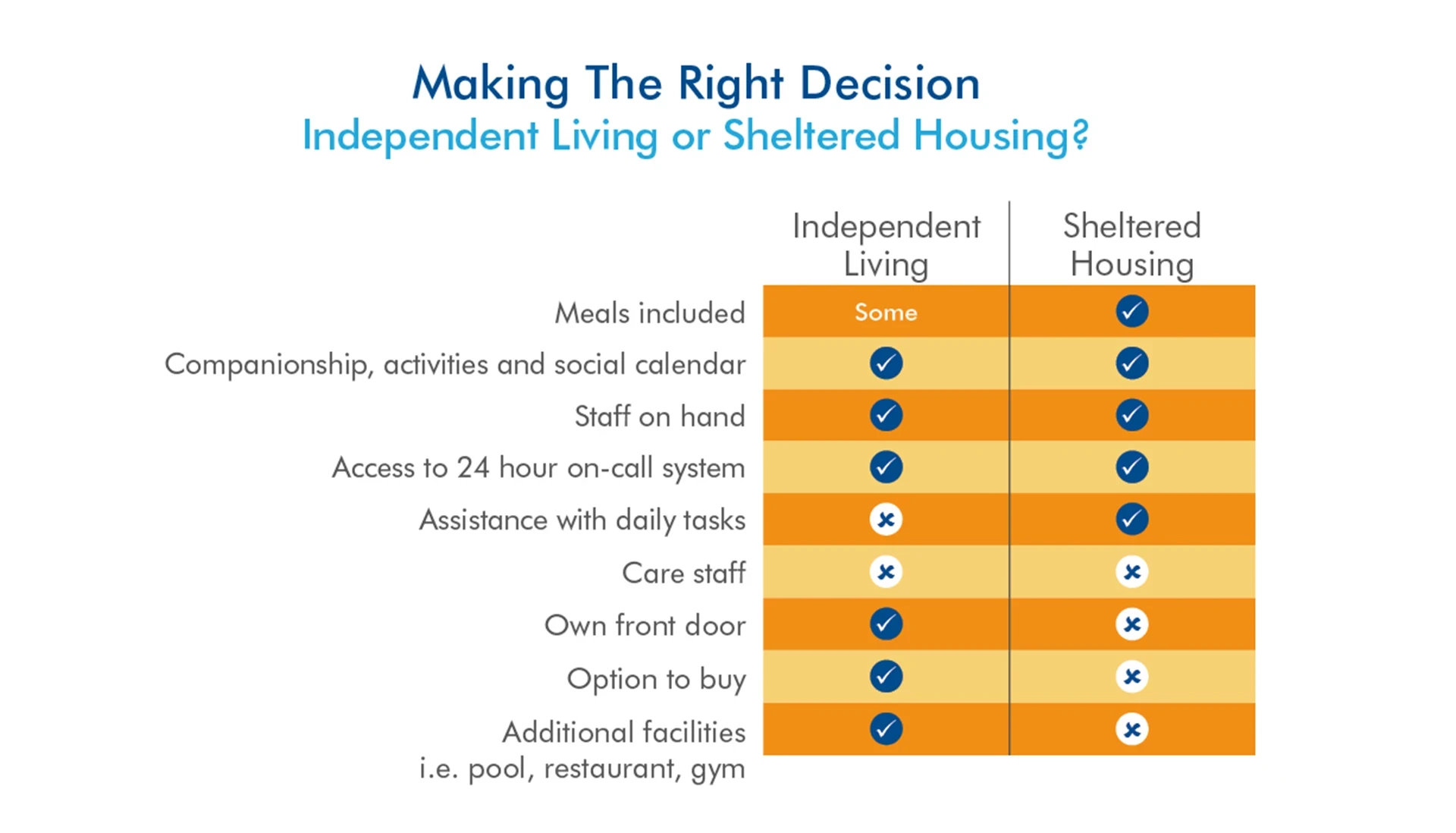Independent Living vs. Sheltered Housing: choosing the right housing option
As we get older, our living arrangements undergo significant changes, typically falling into two categories: independent living and sheltered housing. These housing options, though both focused on safety and support for older people, vary in terms of independence, services and amenities. Here we will explore the key differences between independent living and sheltered housing to help older people and their families make informed choices.
What is independent living?
Independent living for older people refers to housing where the lifestyle is designed to promote autonomy, self-sufficiency, and a high degree of personal freedom, whilst also providing a supportive and safe environment. Independent living communities are designed for older people who are active and wish to maintain their independence whilst enjoying a more maintenance-free lifestyle. This housing option is most suited for older people who are capable of managing most of their daily activities on their own.
What are the key characteristics of independent living?
- Private accommodation: Independent living offers older people their own private living spaces, which can include apartments or flats comprising of their own front door, one or multiple bedrooms, living area and kitchen. The accommodation is tailored for older people and can sometimes include safety features like handrails and emergency call systems.
- Facilities: Independent living facilities can often offer a range of amenities including gyms, restaurants or communal dining areas, libraries, wellbeing facilities, social activities, and hobby clubs. These amenities encourage residents to stay active and engaged with other residents.
- Autonomy: Independent living residents typically have their own private apartments or flat, with the freedom to come and go as they as please. They can set their own schedules and maintain their individual routines. While independence is encouraged, independent living communities may offer optional services such as housekeeping, laundry, and maintenance to make daily life more convenient. These services allow residents to focus on their interests and activities.
- Services: While services like housekeeping and maintenance are typically available, residents are generally responsible for their daily care, including cooking and managing medications. Residents in independent living communities are also expected to manage their personal care independently. This includes activities such as bathing, dressing, grooming, and taking medications without significant assistance. Independent living is ideal for those who can manage these tasks independently.
- Cost: The cost of independent living can vary widely, depending on the location, size of the unit, and the amenities provided. Residents usually pay for their accommodation and any optional services they choose to use. Independent living can offer units to buy or leasehold.
What is sheltered housing?
Sheltered housing for older people is also known as assisted living or supported housing, which has been designed to provide a supportive and safe living environment for older people who may require some assistance with daily activities, but still want their independence. This type of housing is particularly suitable for older people who may not be able to live completely independently in their own homes, but do not need the full range of services provided in a care or nursing home.
What are the key characteristics of sheltered housing?
- Private accommodation: Sheltered housing residents typically have their own private apartment or room within a larger house. Some of the facilities may be shared such as communal lounges, dining rooms, conservatories, and gardens, but personal privacy is still maintained.
- Meals and housekeeping: Most sheltered housing offers communal dining, where residents are provided with nutritious meals. Housekeeping and laundry services may also be included, which helps to reduce daily chores.
- Safety and security: Safety features including emergency call systems and handrails are common in sheltered housing to prevent accidents and provide residents with peace of mind.
- Social activities: Activities and events are organised to help combat loneliness and create a sense of community amongst residents.
- Healthcare coordination: At some sheltered housing schemes, they may coordinate healthcare services such as doctor’s visits or chiropody, ensuring residents have access to necessary medical care.
- Flexibility: Sheltered housing allows residents to adapt their level of personal care as their needs change over time, by hiring in carers who can help with daily living tasks. This flexibility can help older people avoid frequent relocations.
- Cost: The cost of sheltered housing varies depending on factors such as location, the specific services included and residents typically pay a monthly fee at Abbeyfield which includes meals, utility bills, council tax, community alarm system, a house manager, and social activities. Sheltered housing offers rental only.
Choosing the right option: sheltered housing or independent living
Sheltered housing and independent living share the common goal of providing older people with a supportive and secure living environment but differ in the levels of assistance and services offered. Sheltered housing offers a higher degree of support, including assistance with daily tasks, communal dining, and staff availability. In contrast, independent living focuses on preserving autonomy and self-sufficiency, with residents having full control over their daily routine and care. Independent living can also offer amenities and social activities to promote an active and independent lifestyle.
The choice between independent living or sheltered housing depends on the individual’s needs and preferences. Some things to consider when making this decision are:
- Health status: older people who require minimal support may thrive in an independent living facility, whereas older people who require a bit more support with daily tasks may benefit from sheltered housing.
- Future needs: think about how your care needs may change over time. Some retirement living communities offer both independent living and sheltered housing options in the same complex, allowing residents to move if needed.
- Budget: evaluate your finances and the cost of each option. Sheltered housing at Abbeyfield can often be cheaper as the monthly rental cost typically includes meals, council tax and utilities bills.
Independent living at Abbeyfield
At Abbeyfield, our independent living homes allow you to enjoy the comforts of your very own apartment or bungalow, with support from our friendly and welcoming staff whenever you require it. Our purpose-built independent living accommodation features your own front door, fully equipped fitted kitchen, modern wet room bathroom, communal areas to socialise with other residents, flexible additional care services that are available as required, and 24 hour on-call systems.
Sheltered housing at Abbeyfield
At Abbeyfield, our sheltered houses provide a unique blend of communal living in the heart of residential neighbourhood, allowing you to feel a sense of belonging within a welcoming community. In our sheltered houses, you’ll have your own private room, while sharing the larger house with fellow residents. The communal spaces you’ll typically find in our sheltered houses include a dining room, where you can share meals and socialise with other residents, lounges, conservatories, and inviting gardens, creating wonderful opportunities for social interactions and bonding.
In addition to this, each of our sheltered houses are overseen by a dedicated House Manager who ensures the wellbeing and safety of all our residents throughout the day, and for added peace of mind, we offer a community alarm system.
At our sheltered houses, we organise a range of engaging social activities such as coffee mornings, film nights and day outings to further enhance your living experience in our houses.
Making the right choice for you
Choosing between independent living and sheltered housing is a big decision for older people and their families. Both options offer valuable benefits, and the choice should align with the individual's health, lifestyle, and preferences. Careful consideration of the factors mentioned above can help ensure a comfortable and fulfilling living arrangement in the later years of life. It's advisable to go and visit potential sheltered housing and independent living facilities, speak with current residents, and consult with healthcare professionals to make an informed choice that suits the older person’s needs – both present and future – and circumstances.

Next steps

Care Home or Sheltered Housing?
As one of the UK’s longest serving providers of retirement housing, we often hear that people looking for accommodation as they get older don’t always understand the difference between a care home and sheltered housing.

Sheltered Housing Advice: For older people and their families
If you've thought about moving into a retirement home, but are worried about losing your independence, we talk you through all the reasons why sheltered housing might be a good option, answering questions you might have.

Weighing up the benefits of renting or buying a retirement home
There are several benefits of living in a retirement property. If you are thinking about renting or buying a retirement home, we discuss the benefits of each in this guide.
